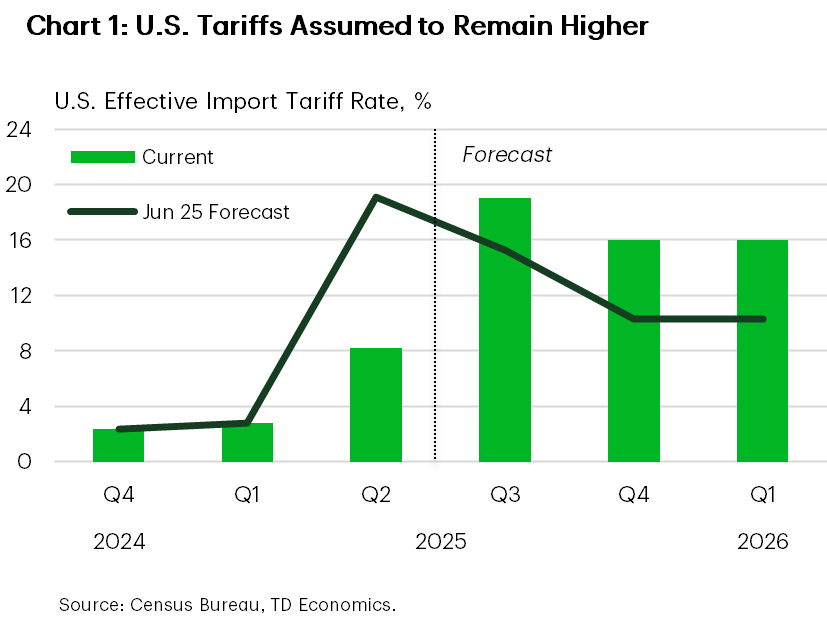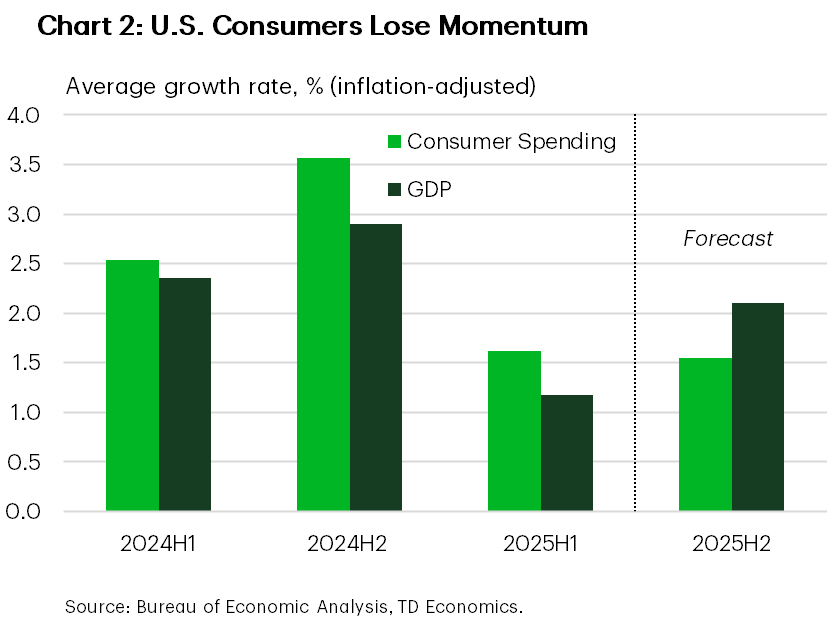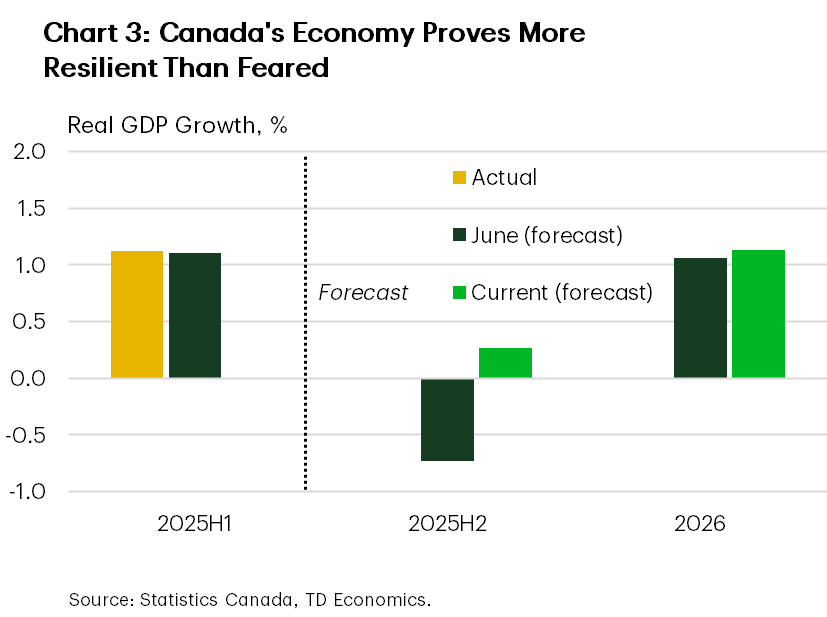- Despite all the twists and turns in U.S. trade policy, our forecast for the global economy is broadly unchanged from our June view.
- Ditto for the U.S. economy, at least on the surface. Consumers have pulled back as the labor market has cooled, but that has been offset by strong business investment. The Fed is expected to cut interest rates further to support the labor market that has cooled further than previously believed.
- Canada’s exports have been hit hard by U.S. tariffs, but consumer spending has shown surprising resilience buoyed in part by a pull-forward in auto purchases and in the face of tariffs. Interest rate cuts have contributed to an uptick in housing activity broadly but are no panacea for the structural headwinds that will continue to weigh on Canada’s economy.

Economists are still suffering from whiplash following the twists and turns of U.S. trade policy. But despite all the back and forth, our forecast for the global economy is broadly unchanged from our view in June. Global growth is on track to advance 3.1% this year, with a slight slowdown in the cards for 2026. In the euro area, GDP rose at a 0.4% annualized pace in Q2, slightly above expectations but sharply slower than the 2.4% pace in Q1. China expanded 5.2% year-on-year in Q2, stronger than forecast, though weak credit growth and continued property stress point to softer momentum in the second half. Japan’s economy grew at a 1.0% annualized rate, beating expectations.
On the trade front, risks have eased for now: the U.S. capped tariffs on the EU at 15% in July, the U.S. extended their truce with China and Mexico in August for 90 days, and the U.S. and Japan reached a limited accord preserving market access. Yet frictions persist, with China imposing new duties on European agricultural goods, and there remains considerable uncertainty around the direction of trade policy once temporary truces expire and if the U.S. Supreme Court rules against the legality of IEEPA tariffs. Front running leading up to President Trump’s reciprocal tariff deadline, originally set for July but subsequently delayed, led to a pull-forward of industrial output and inventory builds. This will likely result in a choppy pace of growth across both advanced and emerging markets depending on trade exposures. The result is a global economy that continues to advance on average, but at an unspectacular pace with divergence among countries. This modest pace is supported by domestic demand and services but constrained by weak goods trade and unsettled policy risks.
U.S. economy softens, more rate cuts ahead
Broadly speaking, the economic narrative remains the same for the U.S. economy as in our June forecast, with growth on track to expand by 1.8% this year. Shifting trade policies remain the biggest source of uncertainty in our forecast and downside risk for the U.S. economy. Given recent trade deals reached with the EU and Japan, we have raised our assumption for the effective tariff rate on imports over the medium term (Chart 1). Higher tariffs have contributed to a slight downgrade to growth in 2026, which is now expected to remain steady at 1.8%, a few tenths lower than in June, although a larger than expected response to the tax cuts in the One Big Beautiful Bill Act is a source of upside risk.

Shifts in tariff policies contributed to volatility in growth over the first half of the year, although private domestic demand held up better than we had expected thanks to sizeable gains in business investment. Business spending on both equipment and intellectual property products, most notably on software, has been very strong. Some of these investments were likely businesses pulling forward outlays to get ahead of any tariff related price increases. But the sizeable increase in computers & other electronics and software investment may represent increased outlays on AI tools. Further gains in computer and electronic imports in July suggest the push on equipment spending could continue into the third quarter.
Consumers have not held up as well. Consumer spending growth more than halved in the first half of the year, to a 1.6% pace as households pulled back on spending on discretionary services in the face of a softer labor market among other impediments (see report). These challenges are expected to restrain consumer spending below 2% over the next four quarters (Chart 2), before lower interest rates, cooler inflation, tax cuts and a better job market push spending back up to a more trend-like 2% pace towards the end of 2026.
The cooling in the labor market has increased the risk of recession and caught the attention of the Federal Reserve. The FOMC resumed lowering interest rates in September, and we expect two more cuts this year. Even though inflation is expected to run above the Fed’s 2% target for some time, data revisions have revealed a more pronounced slowdown in hiring earlier than initially thought, suggesting that the Fed funds rate at 4.5% was too restrictive to foster maximum employment. We expect employment to soften further, leading to net job losses in the fourth quarter and pulling up the unemployment rate to 4.4%. We expect the FOMC to make further interest rate cuts next year to reach a resting point at 3.25%, unchanged from our view in June. Our year-end forecasts for longer-term Treasury yields have come down slightly, reflecting increased conviction by financial markets that the Fed will need to bring rates down from their current restrictive level.
Canada’s economy hammered by U.S. trade war
Canada’s economic growth is set to downshift to a 1.2% pace this year as high U.S. tariffs hammered demand for many Canadian exports. That tally is flattered by a strong hand off from 2024, and growth is forecast to be only 0.6% on a Q4/Q4 basis. The country experienced its largest quarterly decline in exports outside of the 2009 Global Financial Crisis and the Covid-19 pandemic, resulting in a 1.6% contraction in output for the second quarter, which was broadly consistent with our forecast and that of the Bank of Canada.
Our outlook for Canada-U.S. trade relations has shifted; we no longer assume a trade agreement is reached between the two countries this year and that the current tariffs and exemptions remain in place throughout the forecast period. As such, no substantial export recovery in exports appears in the cards. The hit to demand for exports also weighs on prospects for business investment. We forecast non-residential investment will contract in the second half of the year, with knock-on effects on businesses’ need to hire. Consequently, further moderate job losses are likely over the next couple of quarters, raising the unemployment rate to a cyclical peak of 7.3%.

Despite these challenges, there were positive developments in the second quarter, as robust consumer spending and an upswing in housing investment contributed to a hearty 3.5% rebound in domestic demand (Chart 3). Initially, consumer spending and the housing market slowed sharply amid the shock of U.S. trade threats, but both rebounded in the second quarter due to accelerated vehicle purchases and increased tourism-related expenditures by Canadians and visitors. However, these gains are expected to be temporary. Data on monthly vehicle sales suggest a pullback in the third quarter, and a further leg up in domestic tourism appears unlikely. Looking forward, consumer spending is anticipated to remain subdued, reflecting softer labour market fundamentals.
Residential investment is a bright light in the forecast this year. Growth has been revised upward, as the housing market responds to past (and likely some additional) Bank of Canada rate cuts and stronger construction activity is underpinned by purpose-built rentals, thanks to favourable government financing programs. Nevertheless, the long-term contribution of housing to overall growth will continue to be constrained by persistent affordability challenges and slower population growth. And not all markets are rowing in the same direction. For one, the GTA market is currently immersed in a severe slump amid a supply glut of condominiums.
Inflation is expected to remain somewhat elevated in the near term, consistent with our previous projections. We maintain our expectation of an additional rate cut from the Bank of Canada, which would bring the overnight rate to 2.25%. This lower rate environment is likely to persist as Canada adjusts to its new trade “normal”.
Further details on the Liberal government’s fiscal plans will emerge with the upcoming Federal Budget. Overall federal spending is expected to remain a growth support; however, we await more clarity on cost reductions from the expenditure review, the scale and scope of support for major “nation building projects”, and the timing of the new defense commitments. These infrastructure and defense projects typically require extended lead times, and depending on how quickly outlays occur, there could be upside to our forecast that calls for a gradual improvement in real GDP growth to just under 2% by 2027. It’s also worth keeping an eye on the consumer for a pleasant surprise, as uplifts in the Canadian housing market have been known to kickstart spending growth. On the flipside, a further unravelling of the Canada-U.S. trade relationship and the potential for a deterioration in global financial conditions are two downside risks.
Forecast Tables |
|---|
| Interest Rate Outlook |
| Foreign Exchange Outlook |
| Commodity Price Outlook |
| Canadian Economic Outlook |
| U.S. Economic Outlook |
| Economic Indicators: G7 and Europe |
| Global Economic Outlook |
For any media enquiries please contact Oriana Kobelak at 416-982-8061
Disclaimer
This report is provided by TD Economics. It is for informational and educational purposes only as of the date of writing, and may not be appropriate for other purposes. The views and opinions expressed may change at any time based on market or other conditions and may not come to pass. This material is not intended to be relied upon as investment advice or recommendations, does not constitute a solicitation to buy or sell securities and should not be considered specific legal, investment or tax advice. The report does not provide material information about the business and affairs of TD Bank Group and the members of TD Economics are not spokespersons for TD Bank Group with respect to its business and affairs. The information contained in this report has been drawn from sources believed to be reliable, but is not guaranteed to be accurate or complete. This report contains economic analysis and views, including about future economic and financial markets performance. These are based on certain assumptions and other factors, and are subject to inherent risks and uncertainties. The actual outcome may be materially different. The Toronto-Dominion Bank and its affiliates and related entities that comprise the TD Bank Group are not liable for any errors or omissions in the information, analysis or views contained in this report, or for any loss or damage suffered.